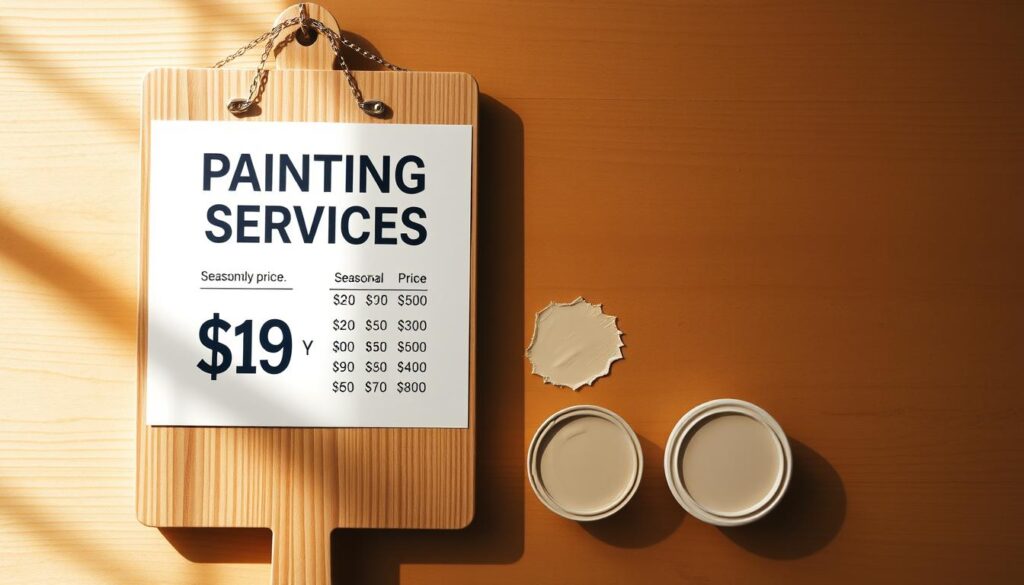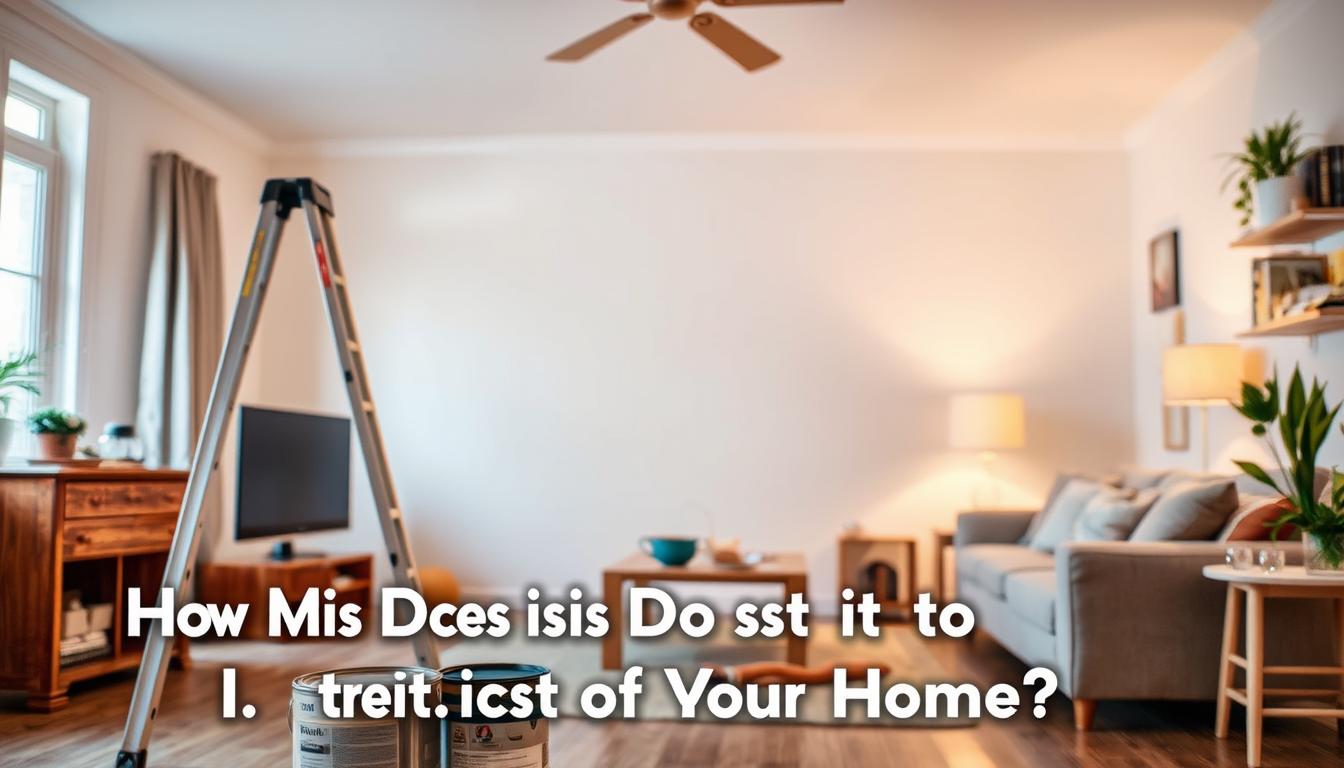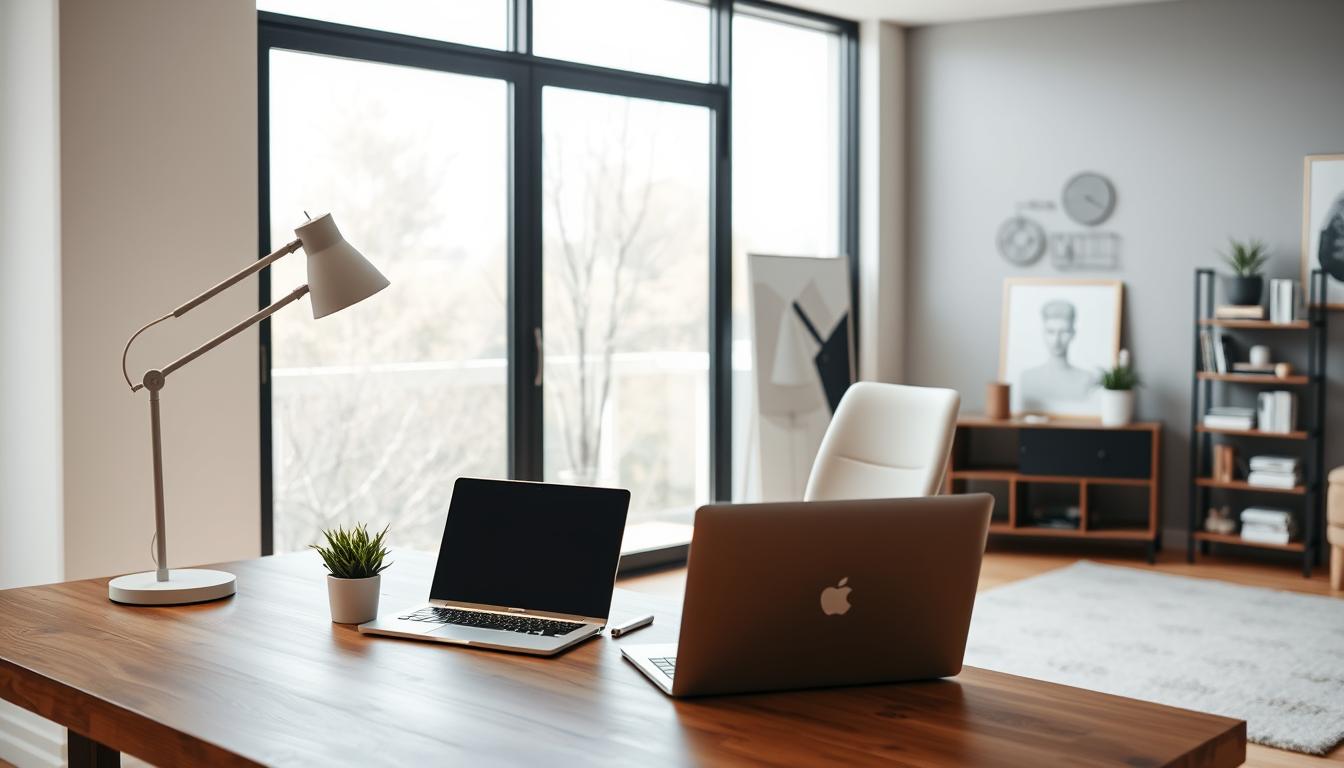Did you know a fresh coat of paint can boost your home’s value by up to 5%? This simple update can greatly enhance your home’s look and its resale value. But, the cost to paint the interior of your home changes a lot. It depends on your home’s size, the number of rooms, and the paint type.
We’ll dive into what makes interior painting costs vary. This will help you plan your next home improvement project with confidence.
Key Takeaways
- The size of your home significantly affects the overall cost.
- Different types of paint vary in price and quality.
- The number of rooms and their condition impact the total expense.
- Additional factors like ceiling height and trim work can add to the cost.
- Professional labor costs can vary depending on location and expertise.
Understanding the Factors Influencing Painting Costs
To get a good estimate for interior painting, it’s key to know what affects the cost. Several important factors play a role, which we’ll dive into.
Type of Paint Used
The paint you choose greatly impacts the cost. Latex paint is often cheaper than oil-based paint. Latex paint is easy to use and dries fast. In contrast, oil-based paints last longer but dry slower and have stronger smells.
Think about the cost of paint and if you might need more coats or touch-ups. Even though high-quality paint costs more, it might mean you won’t have to paint as often.
Square Footage of the Area
The size of the area to paint is also a big deal. Bigger spaces need more paint and labor, raising the cost. Knowing the painting costs per square foot helps estimate the total cost.
Remember to include the ceiling height and the number of windows and doors. These can change how much paint you need.
Condition of the Walls
The walls’ condition is another big factor. Good walls need less prep, but damaged ones might need extra work. This prep work can increase labor costs.
Checking the walls before painting helps spot any repairs needed. This makes the painting process smoother.
Labor Costs
Labor costs make up a big part of painting expenses. The price for professional painters varies by location, experience, and job complexity. When looking for an interior painting estimate, compare quotes from different contractors.
Hiring experienced painters can save you money in the long run. They ensure a quality finish the first time, avoiding future costs.
Average Price Ranges for Interior Painting
When planning to paint your home’s interior, knowing the average costs is key. The price can change based on the area size, paint type, and where you live.
National Averages
Across the country, interior painting costs range from $3 to $4 per square foot. For a 2,000 square foot home, this means spending $6,000 to $8,000. But, these numbers are just estimates, and your project’s details can affect the final cost.
To get a closer estimate, try a house painting cost calculator. It considers things like room count, wall condition, and paint type.
Pricing by Room Size
The room size greatly influences painting costs. Here’s a look at average prices for different room sizes:
| Room Size (Square Feet) | Average Cost |
|---|---|
| 100-200 | $200-$400 |
| 200-400 | $400-$800 |
| 400-600 | $800-$1,200 |
Breakdown by Region
Where you live also affects painting costs. Urban areas usually have higher prices than rural ones because of labor and demand differences.
Knowing these factors helps you plan better. Whether painting one room or your whole house, understanding costs is crucial for making smart choices.
Cost Comparisons: DIY vs. Hiring Professionals
Choosing between DIY and hiring pros for home painting is a big decision. Both ways have good and bad points that affect cost and quality.
Average Costs for DIY Projects
DIY painting costs include paint, brushes, and rollers. Paint prices vary by quality and brand. A gallon can cost $20 to $50.
For a room, you might need 2-3 gallons. This brings the paint cost to $40 to $150. Adding brushes, rollers, and trays can cost another $20 to $50. So, DIY costs for one room can be $60 to $200, not counting wall or ceiling repairs.
Advantages of Hiring Professional Painters
Professional painters offer quality, save time, and use more paints. They prepare surfaces well, paint evenly, and clean up. This ensures a professional look that can boost your home’s value.
Though pros cost more upfront, they include labor, materials, and a work warranty. Prices vary by location, room size, and job complexity. On average, expect to pay $2 to $6 per square foot. For a 1,200 square foot home, this is $800 to $2,400.
Potential Cost Savings
To save, consider DIY or professional painting. For DIY, buying in bulk or during sales helps. For pros, getting quotes, choosing cheaper paint, and painting in the off-season can save money.
| Cost Factor | DIY Costs | Professional Costs |
|---|---|---|
| Paint | $40-$150 per gallon | Included in total cost |
| Materials | $20-$50 | Included in total cost |
| Labor | $0 (your time) | $800-$2,400 for 1,200 sq ft |
| Total | $60-$200 per room | $2-$6 per sq ft |
In summary, DIY can save money, but pros offer quality and can be more cost-effective for big or complex jobs. Think about your budget and needs before deciding.
Seasonal Considerations for Painting
Seasonal factors greatly affect the cost and timing of interior painting. Understanding the best painting times, how weather impacts costs, and the importance of scheduling is key. This knowledge helps homeowners make smart choices.
Best Times of Year to Paint
The best time to paint your home’s interior depends on your location and home conditions. Spring and fall are usually the best seasons. They have mild temperatures and low humidity, making painting smoother and more durable.
Spring and Fall Advantages: These seasons have perfect painting conditions. The moderate temperatures help paint stick better and dry faster. This can result in a better finish and possibly lower costs.
Impact of Weather on Costs
Weather can change the cost of interior painting. It affects the paint and the work needed. Even though interior painting is less weather-dependent than exterior, extreme weather can still impact drying times and quality.

Weather-Related Cost Factors: In areas with harsh weather, you might need special paints or extra coats. This can increase costs. Weather also affects painting service demand, which can impact prices.
Scheduling and Availability
The time of year affects painter availability. Spring and summer are the busiest times, leading to higher prices and longer wait times.
- Planning Ahead: Painting in the off-season (late fall or winter) can save money and offer more painter choices.
- Flexibility: Being flexible with your project’s timing can help you find better deals and availability during slower seasons.
Considering these seasonal factors helps homeowners plan their painting projects wisely. This way, they can get the most value from professional painting services.
How to Get Accurate Estimates
Getting accurate estimates is key to a successful interior painting project. It helps you avoid surprise costs. To get this right, follow a clear process when asking for and checking estimates from painters.
Seeking Multiple Quotes
Getting quotes from several painters is a smart move. It helps you understand the average cost and find the best deal. You can compare services and see who offers the most value.
When asking for quotes, give each painter the same details. Include the area size, paint type, and any special needs you have.
Questions to Ask Painters
Asking the right questions is crucial for accurate estimates. Here are some important ones:
- What’s included in the estimate (labor, materials, cleanup)?
- Are there any extra costs or fees?
- Can you show me examples of your past work?
- When can you finish the project?
- Do you have the right licenses and insurance?
Importance of Detailed Contracts
After picking a contractor, a detailed contract is vital. It should cover the work scope, total cost, payment terms, and project schedule.
A detailed contract protects both you and the contractor. It clearly states what each party must do. This reduces the chance of misunderstandings or disputes later on.
| Contract Element | Description | Importance |
|---|---|---|
| Scope of Work | Details the specific tasks to be performed. | High |
| Total Cost | The overall cost for the project, including all materials and labor. | High |
| Payment Terms | Outlines when payments are due and the accepted methods of payment. | High |
| Project Timeline | Specifies the start and completion dates for the project. | Medium |
Hidden Costs You Might Encounter
When you plan to paint your home’s interior, think about more than just the paint. Other costs can add up quickly. Knowing these costs upfront helps you budget better and avoid surprises.
Prep Work Requirements
Preparation is key for a successful painting project. It’s not just about buying paint. You’ll need to fix holes, sand surfaces, and remove old paint or wallpaper. These tasks take time and might need extra tools or professional help, increasing your cost.
If your walls have old paint or damage, prep work can get expensive. A painting labor cost estimator can give you a better idea of these costs.
Additional Materials and Supplies
You’ll need more than paint for your project. Supplies like brushes, rollers, trays, drop cloths, and possibly primer or special coatings are needed. The quality and brand of these materials affect your total cost.
Here’s a list of potential extra costs for materials and supplies:
| Material | Low-End Cost | High-End Cost |
|---|---|---|
| Primer (1 gallon) | $20 | $50 |
| Paint Brushes (set) | $20 | $100 |
| Drop Cloths | $10 | $50 |
Cleanup and Disposal Fees
After painting, cleaning up is a big task. This includes getting rid of leftover paint and materials, cleaning tools, and removing drop cloths. Some painters include these costs in their quote, but others might charge extra.
It’s important to talk about these costs with your painter. Ask about their cleanup and disposal procedures. Find out if these are included in their initial estimate or if you’ll be billed extra.

Choosing the Right Color and Finish
Choosing the perfect paint color and finish is important. It depends on the room’s purpose, lighting, and what you like. The right choices can change how your home looks and feels.
Factors to Consider When Selecting Paint Colors
Choosing paint color is more than picking a favorite color. It’s about making sure it fits with the room’s look and use. Here are some key things to think about:
- Room Purpose: Different rooms need different colors. For example, bedrooms often use calming colors like blues and greens. But, playrooms or home gyms might do better with brighter colors.
- Lighting: Light can change how paint colors look. It’s smart to test colors under different lights.
- Color Scheme: Think about your furniture, flooring, and fixtures. Make sure the paint color goes well with them.
A study found that room color can affect mood and energy. It can even make a room seem bigger or cozier. This shows how important choosing the right color is.
Popular Trends for Interior Paint
Keeping up with trends can help you make a good choice. Some current favorites include:
- Earth Tones: Green, brown, and beige are popular for their natural feel and calmness.
- Bold Accent Walls: A bold color on one wall can add interest and depth to a room.
- Monochromatic Schemes: Using different shades of the same color can create a smooth, unified look.
How Finish Affects Cost
The paint finish can change how your paint looks and how much it costs. Finishes range from flat (matte) to high-gloss. Glossier finishes are more durable but cost more.
Here’s a quick look at how finish affects cost:
| Finish Type | Cost Impact | Durability |
|---|---|---|
| Flat/Matte | Lower cost | Less durable |
| Satin | Moderate cost | Moderately durable |
| Semi-gloss/High-gloss | Higher cost | Highly durable |
When picking a finish, think about your budget and how durable you need it to be.
Impact of Interior Painting on Home Value
Interior painting can greatly improve your home’s value. It makes your home look better and can increase its worth. Whether you’re selling or just want a nicer home, painting is key.
Long-Term Benefits of Fresh Paint
Fresh paint offers many benefits for your home’s value. These include:
- Enhanced Aesthetic Appeal: A painted interior makes your home look newer and more appealing to buyers.
- Protection of Surfaces: Paint protects walls and ceilings from damage, saving you money on repairs.
- Increased Durability: Quality paint lasts long, keeping your home looking good and surfaces safe.
How Painting Can Enhance Marketability
Painting can make your home more marketable. A fresh interior can speed up sales and raise prices. Here’s how:
- First Impressions Matter: A painted home looks better and makes a great first impression on buyers.
- Perceived Value: Buyers think a well-painted home is worth more than one that’s not.
- Competitive Edge: In a tough market, a painted home stands out.
Return on Investment
Interior painting offers a great return on investment (ROI). Studies show you can get back a lot of what you spend on painting. To get a good interior painting estimate, think about the paint type, area size, and labor costs. A house painting cost calculator can help plan your budget.
Investing in quality paint and professional services can pay off big. Painting is a smart choice for improving your home.
Maintenance and Longevity of Interior Paint
To keep your home’s interior looking great, regular paint maintenance is key. Taking good care of your paint can make it last longer. This keeps your walls beautiful and strong.
Average Lifespan of Different Paint Types
The life of interior paint depends on the type. High-quality latex paint can last 5 to 10 years. But, low-quality paint might need a new coat in 2 to 3 years.
Things like the paint finish and wall conditions also matter. For example, sunlight and moisture can affect how long the paint lasts.
Tips for Extending the Life of Your Paint
To make your paint last longer, regular care is important. Here are some tips:
- Regularly dust and clean walls to prevent dirt buildup.
- Avoid using harsh chemicals that can damage the paint finish.
- Touch up scratches and marks promptly to prevent them from becoming more significant issues.
- Consider using paint with a built-in primer to enhance durability.
By following these simple steps, you can make your paint last longer. This means you won’t need a new coat as often. And, you’ll save money on home interior painting prices in the long run.
Signs It’s Time to Repaint
Knowing when to repaint is important for your home’s look and value. Here are some signs it’s time:
- Fading or discoloration of the paint.
- Cracking or peeling paint, indicating age or moisture issues.
- Difficulty cleaning walls due to a worn finish.
If you see these signs, it might be time to repaint. The average cost of painting a room can vary. But, with careful planning, you can get a fresh look without spending too much.
Final Thoughts on Interior Painting Costs
Exploring interior painting costs shows us many factors play a role. These include the paint type and labor costs. Knowing these helps homeowners update their homes without spending too much.
When planning your painting project, remember the cost to paint walls and ceiling is a big part of the budget. Getting quotes from different contractors can help you find the best professional painting services pricing. Make sure to ask about extra costs, like prep work or cleanup, to avoid surprises.
Budgeting Tips
To get quality and value, focus on detailed contracts and ask about materials and techniques. This way, you’ll get a paint job that makes your home look great and increases its value.
Ensuring a Quality Paint Job
Choose a trusted painting service that offers good prices without cutting corners on quality. Thinking about paint type and finish helps you get a job that looks professional and lasts long.
FAQ
What is the average cost to paint the interior of a home?
How do I estimate the cost of painting a room?
FAQ
What is the average cost to paint the interior of a home?
The cost to paint a home’s interior varies. It depends on the home’s size, paint type, and labor costs. Costs usually range from to per square foot.
How do I estimate the cost of painting a room?
To estimate painting costs, consider the room’s size and paint type. Budget
FAQ
What is the average cost to paint the interior of a home?
The cost to paint a home’s interior varies. It depends on the home’s size, paint type, and labor costs. Costs usually range from $2 to $6 per square foot.
How do I estimate the cost of painting a room?
To estimate painting costs, consider the room’s size and paint type. Budget $1 to $3 per square foot for a single coat.
What factors influence the cost of interior painting?
Several factors affect interior painting costs. These include paint type, area size, wall condition, and labor. We also look at job complexity and prep work needed.
Is it cheaper to paint my home myself or hire a professional?
DIY painting can save money, but professionals offer a quality finish. Consider material, equipment, and time costs when deciding.
How does the type of paint affect the overall cost?
Paint type greatly impacts cost. Specialty or eco-friendly paints are pricier than standard ones. We choose paint based on durability, finish, and color retention.
Are there any hidden costs associated with interior painting?
Yes, hidden costs include prep work, extra materials, and cleanup fees. Include these in your budget to avoid surprises.
How do I choose the right paint color and finish for my project?
We consider room purpose, lighting, and decor when choosing paint. We also look at trends and desired ambiance. Finish choice affects cost, with glossier finishes being pricier.
Can interior painting increase my home’s value?
Yes, painting can boost your home’s value by making it more appealing. A fresh coat can significantly impact buyer perception. We recommend considering long-term benefits and potential ROI.
How often should I repaint my home’s interior?
Repainting frequency varies based on paint type, wear, and personal preference. We suggest repainting every 5 to 10 years, or as needed.
What are some tips for extending the life of my interior paint?
To extend paint life, clean regularly, avoid harsh chemicals, and touch up scratches. Proper prep and application are key for a lasting finish.
to per square foot for a single coat.
What factors influence the cost of interior painting?
Several factors affect interior painting costs. These include paint type, area size, wall condition, and labor. We also look at job complexity and prep work needed.
Is it cheaper to paint my home myself or hire a professional?
DIY painting can save money, but professionals offer a quality finish. Consider material, equipment, and time costs when deciding.
How does the type of paint affect the overall cost?
Paint type greatly impacts cost. Specialty or eco-friendly paints are pricier than standard ones. We choose paint based on durability, finish, and color retention.
Are there any hidden costs associated with interior painting?
Yes, hidden costs include prep work, extra materials, and cleanup fees. Include these in your budget to avoid surprises.
How do I choose the right paint color and finish for my project?
We consider room purpose, lighting, and decor when choosing paint. We also look at trends and desired ambiance. Finish choice affects cost, with glossier finishes being pricier.
Can interior painting increase my home’s value?
Yes, painting can boost your home’s value by making it more appealing. A fresh coat can significantly impact buyer perception. We recommend considering long-term benefits and potential ROI.
How often should I repaint my home’s interior?
Repainting frequency varies based on paint type, wear, and personal preference. We suggest repainting every 5 to 10 years, or as needed.
What are some tips for extending the life of my interior paint?
To extend paint life, clean regularly, avoid harsh chemicals, and touch up scratches. Proper prep and application are key for a lasting finish.


